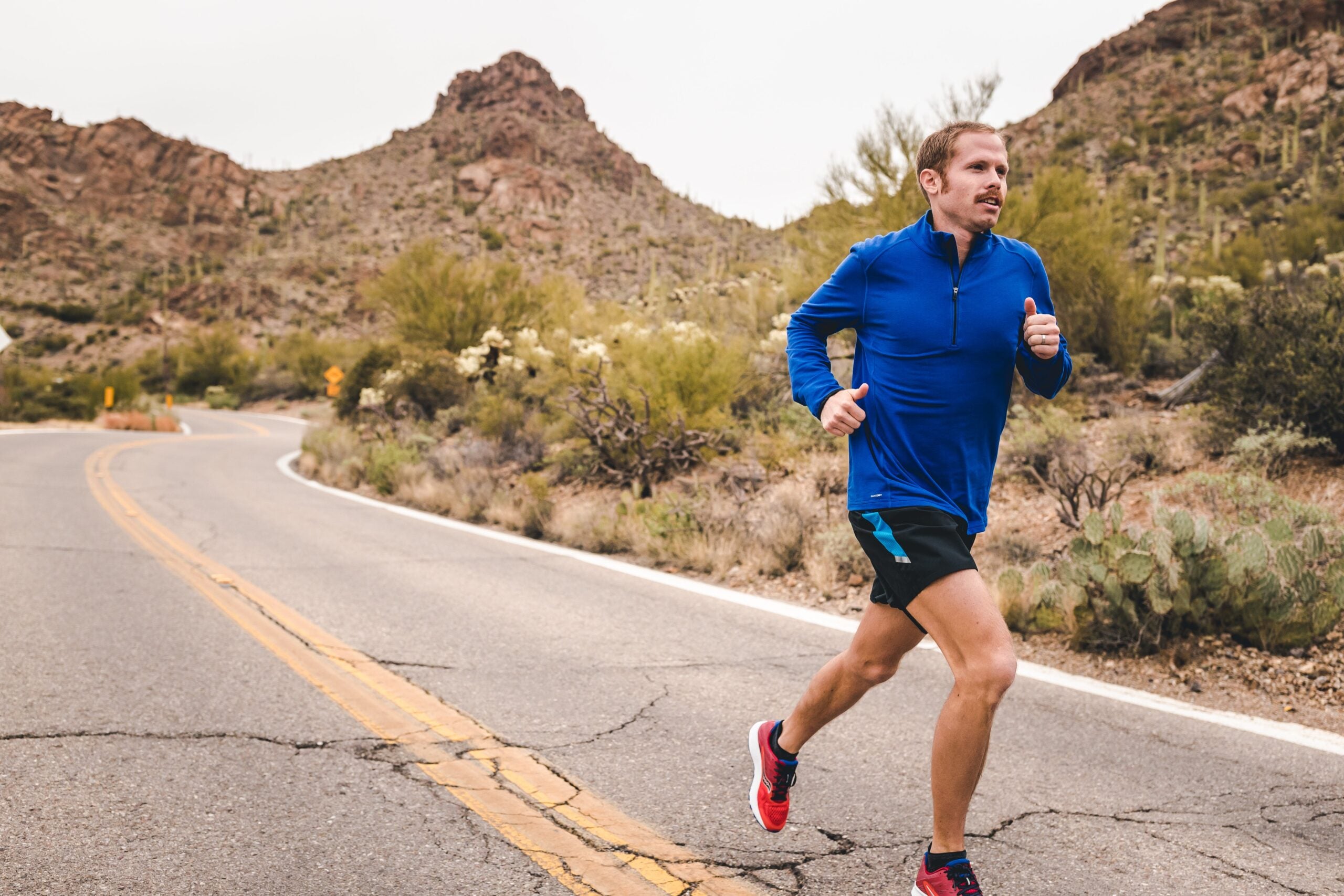If you’re like me, you enjoy seeing how the best athletes train. It is fascinating to see the miles and workouts required to compete for the podium at national and international races. The miles they put in are staggering and the speed they can run, awe-inspiring.
We can do more than marvel at these training logs they reveal, however—we can learn from them. And we should. We know that they work: this is what the runners who are leading the pack do, this is how you train when you have all the time and resources you need to make sure you’re at your best.
Given that most of us don’t have the time, resources or gifts of the elites, we can’t follow the plans exactly—we can’t even follow any one workout exactly. Instead, we have to look at the training examples in their context, pull out principles and proportions, and scale and apply these to our context. Here are four ways to tailor an elite training plan to fit your running.
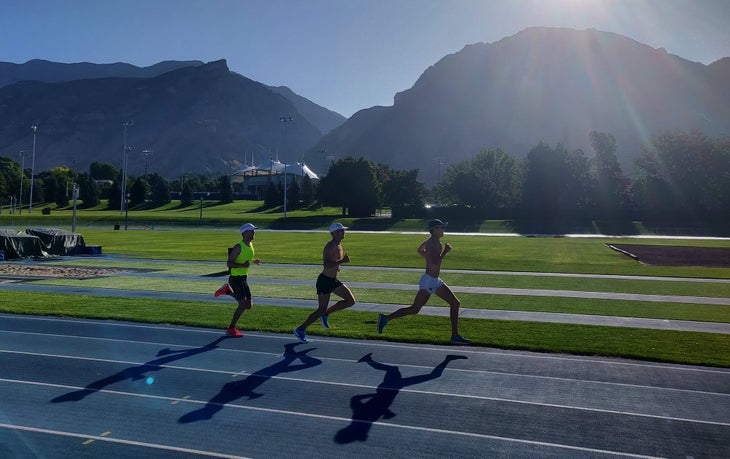
1) Pay Attention to Times and Ratios
If you take a look at Jared Ward’s log in the heart of marathon training, five weeks out from the trials, it is, as expected, impressive. During one week, he put in 100 miles with an average pace around 6-minute miles, mile repeats in the low 4s, and a 22-mile progression working down to a 4:46 pace. It feels super-human, with very little resemblance to my training this spring. While I’m also marathon training, I’m 55, with a challenging, full-time job, and have never been in the same cohort as the likes of Ward. This spring, I’m working up to 60 miles/week and averaging over 8 minutes/mile.
But when I broke Ward’s example down a bit, it became more manageable and applicable. First, I looked up Ward’s marathon pace, which is about 4:55/mile. Using this, I could put every run in context.
Scaling the paces to my current context, his training doesn’t feel as mind-boggling. Since I’m aiming to run in the mid 3:20s later this spring, my marathon pace is around 7:45/mile. That would make my equivalent of Ward’s average of 6:00/mile fall roughly at 8:50/mile for me, a pace that feels like a very easy run.
Getting into more detail about his training patterns, during his hundred-mile week, I calculated that Ward ran about 8.5 miles faster than marathon pace, with 5.5 at threshold or faster and 3 at marathon pace. He ran about 11 miles close to marathon pace, 55 miles at 44–65 seconds slower than marathon pace (in the 5:40 to 6:00 range), and the remaining 25.5 even slower, sometimes 2:30/mile slower than marathon pace.
Not surprisingly, Ward’s faster miles fall less than 20% of his weekly miles. A large body of evidence shows that training is most effective when 80% is easy and no more than 20% is at moderate to high intensity. Elite endurance athletes demonstrate this ratio in their training, and research shows it holds true even for recreational runners training less than four hours per week.
If I’m to run like Ward, I shouldn’t echo his near-20 miles of higher intensity running, but scale the miles to a similar percentage of my total volume. Assuming a 60-mile week, that works out to 11.5 miles running faster than my marathon pace, with only 4.5 of that run faster than threshold. Following Ward’s model, I would run 32 miles at roughly 45–65 seconds per mile slower than marathon pace, and 16 miles at a very easy recovery jog. Right now, early in my buildup to that volume, I am scaling to 40 mpw and only doing one faster workout per week to keep the percentage of total volume in line, which also keeps the density of training appropriate to how fast I can recover.
Applying these ratios, Ward’s week, scaled to my distance (60 miles per week) and paces (7:45 marathon pace), might look like this:
Monday: 6 miles at 8:30
Tuesday: Fatigued repeats: 6 miles moderate (working down to about 8:10) plus 3 x 1200m repeats at approximately 90% of my marathon pace or just under 7:00/mile
Wednesday: 6 miles easy—9+ min/mile
Thursday: On/off fartlek of 600m at approximately 5K pace for 1.5 miles, plus 6 miles easy warm-up and cooldown
Friday: 7 miles progression, working down to last 3 at 7:40–7:20
Saturday: 6 miles at 8:30, let it drift up if tired or down if feeling good
Sunday: 16–18 mile long run with 4 at marathon pace or slightly faster (7:45–7:35)
That is a completely doable, if challenging, week—and I’m training like Jared Ward!
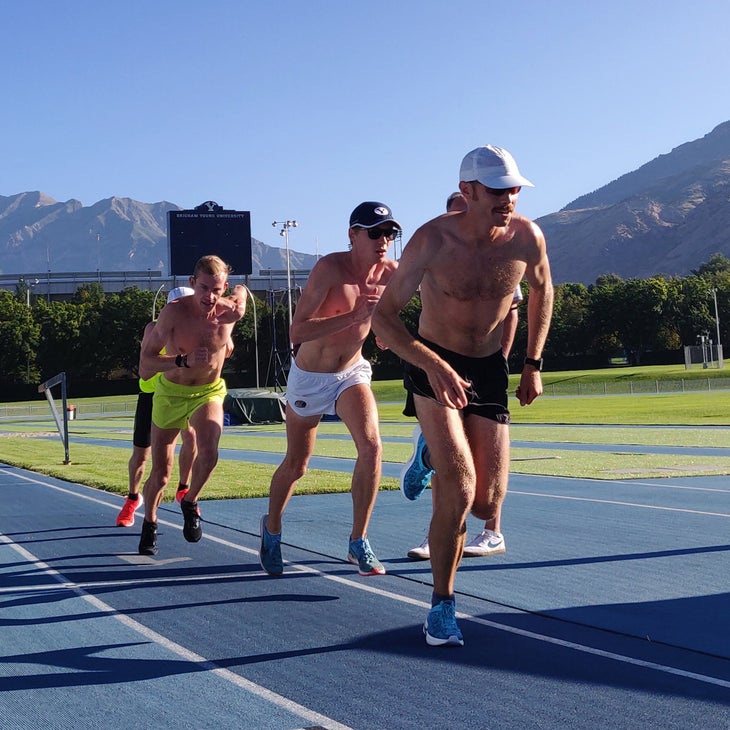
2) Scale Workouts to Time
Note that as we echo elite training plans, we not only have to scale the big patterns to our realities but also the specifics. During Ward’s week, he did mile repeats on Tuesday, and 800m on/off fartlek segments on Thursday. In my plan above, I scaled these workouts down to 1200m and 600m.
You may wonder, doesn’t this change the workout? The reality is no: In my context, following the exact distances would actually make it a different workout.
Online coach Cory Smith, who deals with athletes of a wide range of abilities, explains: “The biggest adjustment, I think, is that the intermediate amateur needs to look at the time it takes the elite to run any given rep of a workout, not the distance.”
Smith gives the example of an elite threshold workout of 12 x 1k @ 3:02–2:54 with 60 seconds rest. This puts the elite’s threshold pace at a little under 5 minutes/mile. If a runner with a threshold pace of 8 minutes per mile tries to run 1k repeats—like the elite—it would take them 5 minutes per 1k repeat, rather than 3 minutes.
“This is a very different workout,” Smith says. “The amateur is running 2 minutes longer per rep than the elite is, and taking the same rest. The work-to-rest ratio is way off. The amateur would be better off doing 10 x 600m @ 3:00 with 60 seconds rest. Same zone, same total time per rep and per workout with the same work-to-rest ratio.”
Scaling speed work to equivalent times allow us to do even legendary workouts like Steve Prefontaine’s 30/40s, alternating 30- and 40-second 200s. Rather than all-out sprint alternating with a slightly slower sprint, they become 30 seconds at vVO2 max and 30–40 seconds at threshold. “Pre’s famous workout sounds fast largely because Pre was fast,” Richard Lovett wrote describing the workout principles for us. “Scale it down … and maybe you can reap the same benefits.”
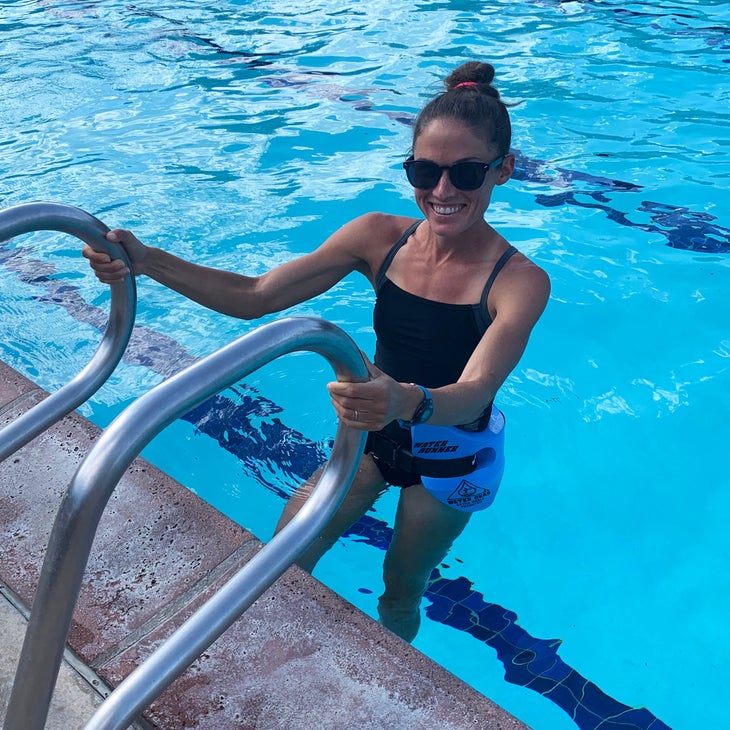
Pull Out Patterns and Principles
One of the most basic ways of learning from elite examples is to find things they are doing that we may not be, and look for revealing patterns.
An example: In his training log, Ward specified what shoes he wore each day. Even though he has access to as many pairs as he needs or wants of the Saucony Endorphin Pro—the super shoe he helped design, and, even though it seems someone with his efficient stride could wear them regularly without getting too beat up, he wore them only for mile repeats, not even for his tempo run or long run progression.
I asked him why. “I’m still not sure if shoes so rigid are good for long-term low-leg health,” Ward replied. “So while I’m willing to race in a shoe that’s faster than another, I’m not ready to train in them too much yet. I’ve never done a long run in them, but I did do an 11-mile tempo in them the following week. The Saucony developer thinks there might be something to only racing in them (not training too much) to gain their advantage.”
The principle for us? Don’t train much in your fastest racing shoes, and be a bit leery of the super shoes, at of least doing many of your miles in them.
Another example: Ward shares that he added cross training on the stationary bike several times a week, adding up to 2 and half hours. Becky Wade, in a similar training week, put in 2 hours of water jogging in the pool.
The principle? Both runners found it valuable to spend precious time and energy on an alternative, lower-impact aerobic activity. While our available time is less, when training starts to beat us up, we should seriously consider using some of the time we have doing an alternative aerobic activity rather than pushing more miles.
Principles like this can be pulled from any top runner’s training, and applied to any runner. Amby Burfoot does this well, as he did from 2:12 marathoner Connor McMillan after his NYCM breakthrough, and from the coach of 10 Olympic Marathon Trials qualifiers this week.
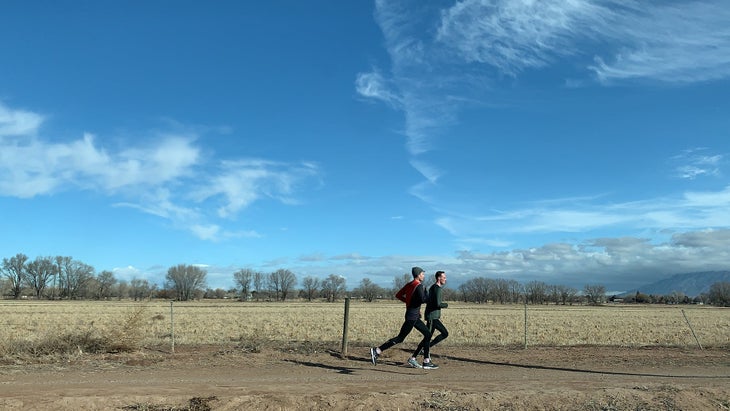
Notice Feelings
Paying attention to how the elites say they feel can give us a final clue that will help us scale our training appropriately. Ward, for example, was doing the biking because of a pain in his foot that he didn’t want to exacerbate. In a training log last fall, Wade told how she cut a planned run short, “since my stride felt off and legs were not warming up. I have no problem rallying through a run on legs that are heavy, even flat, but I’ve learned through experience that pushing through a compromised gait is rarely worth it.”
What these runners reveal in these examples is that they pay attention to their bodies and adapt for how much they have recovered. Luke Humphrey, owner of Luke Humphrey Running and the author of Hansons First Marathon: Step Up to 26.2 the Hansons Way, says, “The setup process is really the same for all the athletes we work with. At the end of the day, the goal is to get the maximum sustainable workload without getting hurt! That’s a pretty universal goal.”
How do you know how much you can take and still recover? Humphrey relies on runner’s feedback as well as history. “A lot of what I give runners depends more on experience than it does ability,” Humphrey says. “I’ll also look at workload in relation to where they are at in their schedule.” He’ll use data trends gathered from smart watches, but in the end, communication is critical.
Self-coached runners should have the best communication possible: We can feel exactly how we’re handling the work. But we have to pay attention, know what it should feel like, and be willing to adapt.
Elites’ examples can help show how it feels to train appropriately. Besides the times when they tell that they’re pushing too hard, they also reveal how it feels when things are clicking. Ward says of a recovery day during his key marathon-training week, “I was pleasantly surprised with how good I felt following the workout yesterday … I was floating.” Matt McDonald says, about a slightly-too-fast recovery run in the middle of a lifetime-best 135-mile week, “I try not to fret about feeling good.” Wade says about a long run that she was, “comfortably averaging in the 6:40s. My legs officially feel recovered from the race a week ago.”
This is how it feels to be working hard, yet recovering. We should feel the same. If our recovery runs don’t feel good—comfortable, floating—we’re probably overdoing it, either in volume or pace or both.
We can’t run as fast or as far as our heroes, but we can feel like they feel, paying attention to the inevitable soreness, fatigue and niggles—and delighting in growing strength, speed, and endurance as we combine all the elite-proven elements of training.


